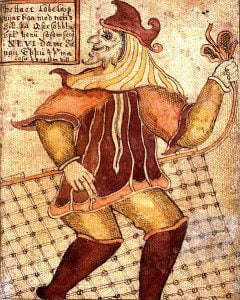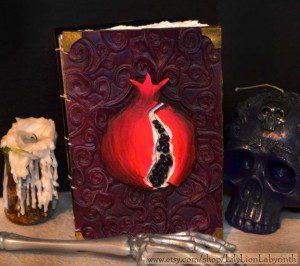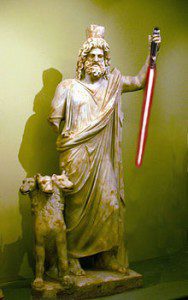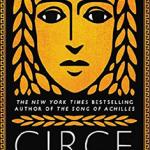Has anyone else noticed how many people are saying that they’ve seen Loki with black hair recently?
It’s a significant point because in all of the Lore, Loki’s hair, when it’s described, is fiery red. That’s the traditional image. But this isn’t uncommon. It’s happening all over the place. People are arguing about it in forums and Facebook groups.
I’m guessing that it comes from this:
From Thor (2011). Courtesy of Disney and Marvel. As a result, for some people, Loki will forever look like Tom Hiddleston.

But is a black-haired Loki less real? To answer that, I guess you have to ask yourself whether or not you believe that the deities are static, or whether you believe that They change over time? And if They do, why do They change?
The archetypist might argue that deities represent important ideas that affect the human subconscious. Myth endures because it is important. There are some human questions that are so innate to the nature of being human that they never go out of style, and the issues they represent will always be with us. So the figures in those myths should remain as they were originally transcribed by our ancestors.
The polytheist might argue that the Lore teaches us all that we need to know about the gods, and that to be a myth, one must possess a certain static character. The gods do not follow such human weirdness as fashion and culture. To suggest that They do makes Them something lesser than what They are, subject to our frailties.
In both cases I would disagree.
Not with the original sentiments. Yes, I think that in order to be a myth, a story must speak directly to something enduring in the human condition. And yes, I think that the gods do maintain a somewhat essential personality that is unchanged by time, probably because They are not corporeal and are not required to deal with the transformative physical elements that humanity must confront, such as aging and death. Well, at least not often, though of course we have tales of some of the exceptions.
But I think that in order to stay relevant, gods must be understood in the context of the culture They are interacting with. A devotionalist might opine that deities that cannot effectively relate to, and communicate with, Their followers, soon have no followers. A humanist might opine that humanity does not need deities that are too anachronistic to matter. Do the gods exist because humanity needs Them to, or does humanity exist because the gods need us to? Either way, there needs to be some exchange — some relationship — between deities and mortals in order for deities to have an active following and faith. And if we are literally speaking a different language — never mind the barriers between corporeal and incorporeal beings communicating in the first place — then forming that relationship becomes even more challenging.
If the deities are archetypes, the essential character of that archetype will remain unchanging, but its expression surely will change, depending on the culture it is being expressed in. This is why Astarte expresses differently from Aphrodite, who expresses differently from Inanna, who expresses differently from Erzulie. And if that’s true, why could there not be little changes over time? Like, why shouldn’t Loki suddenly start appearing with black hair, after millions of people who may never have been exposed to Loki before, see Him for the first time in the Avengers movie and latch on to an archetype desperately missing in our culture?
If the deities are individuals with agency, then why shouldn’t Loki suddenly start astrally dyeing His hair? Maybe He likes the badass, slightly tragic image that has all the young women (and more than a few young men or people of variant-gender) swooning in the Avengers movies, and maybe He wants to pick up swooning young women (and men and people who identify as genderqueer, and possibly horses)? Maybe He decided that He didn’t want to be a redhead in a day and age in which we have jokes about gingers having no souls and beating up the “redheaded stepchild.” Maybe He bought some Just for Men because He’s starting to go gray after a thousand years.
Changes might be more profound than hair colour. For instance, are you aware that some time over the past thirty years, Persephone has become the undisputed goddess of kink?
From Percy Jackson & the Olympians: the Lightning Thief (video game). Courtesy of 20th Century Fox and Nintendo.
!["Proserpina" by Dante Gabriel Rossetti [Public domain], via Wikimedia Commons](https://wp-media.patheos.com/blogs/sites/482/2015/03/Proserpina_by_Dante_Gabriel_Rossetti-207x300.jpg)
Where does this idea come from? Well, if you’ll pardon the pun, I think the seeds of it were formed in Jean Shinoda Bolen’s classic of women’s spirituality, Goddesses in Everywoman, first published in 1984 and reprinted many times since (including a recent 30th Anniversary edition). In this formative book, Bolen reinterpreted the Persephone myth to suggest that Persephone chose to eat the pomegranate seeds and remain with Hades as co-equal ruler of the Underworld, rather than return full time to Her mother’s keeping.
And Bolen perhaps borrowed (or unconsciously echoed) the retelling of this myth that is a part of British Traditional Witchcraft, in which the Goddess descends to the Underworld to demand why the Lord of the Underworld causes all that She loves to die. He explains that it is not His doing, but Age and Fate; perhaps a simple explanation that the nature of all matter is entropy. He falls in love with Her and begs Her to stay as He lays His sword and crown at Her feet; She refuses. He binds Her and introduces Her to the Scourge; and wins Her heart. He teaches Her the mysteries of Death; She teaches Him the mysteries of Life and Rebirth.

The Descent of the Goddess is clearly drawn from the tales of Persephone and Inanna. And for those who know something about the dynamics of it, bursting with BDSM elements. The Lady submits to the Scourge and “feels the pangs of Love;” but the Lord “lays His sword and crown at Her feet.” As any dom knows, the sub is the one who runs the show. The sub decides what the limits are and what the safe-word shall be, and it is the dom who is required to meet the needs of the sub. If that doesn’t reassure critics that the Descent of the Goddess is not a rape fantasy, the Lord also (in other tales) submits to the Scourge of the Lady. I can’t help but think, with different strains of witchcraft all intermingling in the late 70s and early 80s, that this influenced Bolen’s understanding of the Persephone myth, and her decision to view the eating of the pomegranate seeds as a conscious choice.
Bolen sees the Persephone myth as an important one for all women, speaking to the human condition of growing up, leaving our mother’s shadow and coming into ourselves, perhaps by making choices that our mothers may not have made. (Or echoing those choices, I suppose — Persephone was the daughter of Zeus and Demeter, after all). Another interpretation of the myth that Bolen makes is to suggest that in Persephone’s story, we can find the story of any woman who has come through a crucible of transformation to become stronger than she was before. In a way, Persephone is the feminist answer to Joseph Campbell’s Hero’s Journey; which has been criticized for not effectively speaking to women’s experiences. From this point of view, Persephone is often interpreted by modern Dianic witches as the protectress of women who have left abusive relationships, and I think this has clearly become part of Her story also.
But there’s certainly a kinky subtext if one is looking for it, isn’t there? Rather than interpreting it as a rape metaphor, one could interpret it this way: powerful, slightly sinister, dominant Hades falls in love with a Maiden (remember that Kore means “Maiden”) and takes Her away to His dungeon to initiate Her into the mysteries of being an adult (read: sex). In the Underworld, the Kore discovers a fine line between pleasure and pain and enjoys Her new role. But while She might sub for Hades, to everyone else She’s definitely a domme, and She takes Her place as Queen of the Underworld and adopts a new title: Persephone (which means “the Queen of Bloody Murder.”) In the meantime, Her family does not approve and demands that She return to the vanilla world. She has no choice but to adapt to the outside world’s standards, at least at this time, but She eats the pomegranate seeds in a conscious choice to remain in the Underworld and continue, at least part of the time, to rule as the Queen of Hell. She even takes Her own lover, Adonis, who is required afterwards to spend a third of each year in the Underworld with Her.
If you think this view of the myth is offensive, or has outlived its relevance, I’ll remind you of the popularity of Fifty Shades of Grey (which is not, as any member of the kink community could tell you, what real BDSM looks like, but obviously people are ready to find out.) Also note the popularity of the vampire mythos and the paranormal romance.
At any rate, due to these influences, conscious or unconscious, Persephone now has an aspect, in North America at least, that wears leathers and spiky heels; something that I am sure was never intended by the ancient Greeks! But does that make it any less real? I doubt that any of the Priestesses and Priests doing sacred sex and ordeal work with and for the Queen of Hell would particularly care whether or not anthropologists would substantiate their Goddess of Kink.

In the meantime, Hades has His own stuff going on in pop culture.
For instance, since He’s often conflated with the Romanized version, Pluto, it’s certainly not insignificant that the New Horizons probe just did its famous flyby. What we found there was not what we expected. Big pink planet with big pink heart is hardly what we think of when we consider Hades. And then there’s Charon, so big that together they qualify as a binary dwarf planet; not at all what we were expecting there either. I find myself wondering how much of this will make its way into the mythology of Hades and associates over the next ten or twenty years. Will Charon take on more significance in the tales of the Underworld, rather than being colloquially known as “the Ferryman”?
As you might expect, much of Hades’ geography is being named for Underworld deities and creatures (not sure how I feel about a place called “Cthulu” on the outer reaches of our space, but be that as it may . . .). But there’s also a trend towards somewhat nerdy names drawn from mythology, but also from Tolkien and Lovecraft. And Charon is probably officially now the geekiest world in the universe, since its place names are drawn from the depths of science fiction fandom, including (but not limited to) Star Wars, Alien, Doctor Who, Firefly, Star Trek, and 2001: A Space Odyssey.
As a science fiction and fantasy geek, I think this is kind of fun and I like it a lot. But I find myself wondering if this is going to have some kind of effect on how we see Hades over the next generation or two, and how people experience Him. Will Hades suddenly start showing up at sci-fi conventions dressed as a Sith Lord and wielding a red-glowing lightsaber?
Personally I had Hephaestus pegged for the candidate Most Likely to Become the God of Nerds. Or possibly Hermes. But I can see why it could be Hades. First of all, He’s always been the “geek in the basement,” so to speak, and secondly, we were primed with this:
From Hercules. Courtesy of Disney.
Though this one is definitely more Sith Lordish:
From Clash of the Titans (2010). Courtesy of Warner Bros.
If we do see this change, the question is: does our idea of what Hades may or may not associate with actually affect what He does? Do our perspectives of the deities change their personalities? Or do the places where our realities and mythology touch transform because that’s the way the deities want things — in other words, did we decide to name Pluto and Charon’s geography with this weird nerdy stuff because Pluto (and/or Hades) and Charon like this weird nerdy stuff? Or, do the deities remain unchanging, but because these associations mean something to us, the gods adopt them in order to communicate more effectively? And are we truly experiencing the deities, or do we experience reflections; avatars, if you will (as Sam Webster suggested in his recent article)? If so, shouldn’t we always try to keep our personal biases and filters in mind when trying to understand Their messages?
This might sound like a non-sequitur but I’d like to put this to the test. If you’d like to engage in a social/theological experiment with me, I invite anyone who has had an experience in dealing with Hecate — recently or at any point in the past — to write to me in email about what She was like, along with the approximate date of the encounter. There will be a follow-up article when I have accumulated a few responses.
I guess the question we have to ask is, whose opinion on Athena is more relevant: Homer’s or Jean Shinoda Bolen’s? Or are they both of equal relevance, or none, depending on context? Ultimately, our own relationships with the Divine are just that: our own, and we have only ourselves and our gods to answer to.
* Special thanks to Lily Lion Labyrinth at Etsy for allowing me to use a picture of her spectacular pomegranate Persephone journal! Check out her store!
Want to share this article and can’t find the buttons? Chances are that your AdBlock is blocking them after a recent update. You may have to Pause AdBlock and reload this page to share them. Or try Firefox. Sorry for the inconvenience!
Like Between the Shadows on Facebook and never miss a post!

















